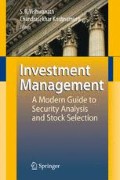Access this chapter
Tax calculation will be finalised at checkout
Purchases are for personal use only
Notes
- 1.
- 2.
See, for example, Baker and Sesia (2007).
- 3.
This question has been adapted from “Introduction to behavioral finance,” Undiscovered managers LLC, 1999.
References
Baker M, Sesia A (2007) Behavioral finance at J P Morgan. HBS Case Study 9-207-084
Barber BM, Odean T (2000) Trading is hazardous to your wealth: The common stock investment performance of individual investors. J Finance 55
Barber B, Odean T (2001) Boys will be boys: Gender, overconfidence, and common stok investment. Quart J Econ 116
Barberis N, Thaler R (2003) A survey of behavioral finance. In: Constantinides G, Harris M, Stulz R (eds) Handbook of the economics of finance. North Holland, Amsterdam
Burton M, Mullainathan S (2005) Market efficiency versus behavioral finance. J Appl Corpor Finance17:3
Fama E (1998) Market efficiency, long-term returns and behavioral finance. J Financial Econ 49
Froot K, Debora E (1999) How are stock prices affected by the location of trade? J Financial Econ 53
Owen AL, Thaler RH (2004) Can the market add and subtract? Mispricing in tech stock carve-outs. J Polit Econ 111
Ritter J (2003) Behavioral finance. Pacific Basin J 11:4
Shefrin H (2000) Beyond fear and greed. HBS, Boston
Shleifer A, Vishny R (1997) The limits of arbitrage. J Finance 52
Statman M (1999) Behavioral finance: past battles and future engagements. Financial Anal J November–December
Subrahmanyam A (2007) Behavioral finance: a review and synthesis. Eur Financial Manage 14:1
Thaler R (1999) The end of behavioral finance. Financial Anal J November–December
Author information
Authors and Affiliations
Corresponding author
Editor information
Editors and Affiliations
Rights and permissions
Copyright information
© 2009 Springer-Verlag Berlin Heidelberg
About this chapter
Cite this chapter
Krishnamurti, C. (2009). Behavioral Finance and Investment Strategy. In: Krishnamurti, C., Vishwanath, R. (eds) Investment Management. Springer, Berlin, Heidelberg. https://doi.org/10.1007/978-3-540-88802-4_28
Download citation
DOI: https://doi.org/10.1007/978-3-540-88802-4_28
Published:
Publisher Name: Springer, Berlin, Heidelberg
Print ISBN: 978-3-540-88801-7
Online ISBN: 978-3-540-88802-4
eBook Packages: Business and EconomicsEconomics and Finance (R0)

